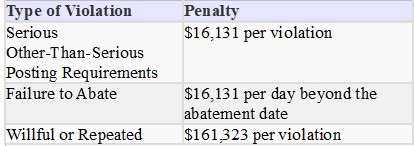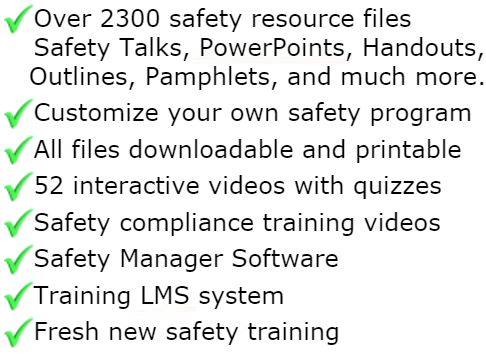
Construction Fall Protection Safety Program
Purpose
The purpose of the fall protection program is to:
• ensure all construction areas are free from uncontrolled fall hazards
• all employees are properly trained in fall prevention and protection
• fall prevention systems are inspected and monitored to ensure effectiveness
Policy
It is the policy of [Company] to take all practical measures possible to prevent employees from being injured by falls. We will take necessary steps to eliminate, prevent, and control fall hazards. We will comply fully with the OSHA Fall Protection standard (CFR 1926, Subpart M, Fall Protection). The first priority is given to the elimination of fall hazards. If a fall hazard cannot be eliminated, effective fall protection will be planned, implemented, and monitored to control the risks of injury due to falling.
All employees exposed to potential falls from heights will be trained to minimize the exposures. Fall protection equipment will be provided and its use required by all employees. Foreman will be responsible for implementation of a fall protection plan for their jobsite.
Hazard Identification
The foreman on each jobsite will be responsible for identifying fall hazards on their jobsite. The foreman will evaluate each situation or work procedure where employees may be exposed to a fall of 6 feet or more. The foreman will be responsible for developing a plan to eliminate the exposures, if possible, or to select the appropriate fall protection systems and/or equipment.
Hazard Control
Engineering Controls
• Personal Fall Protection
• Guard Rail Systems
• Positioning Devices
• Warning Line Systems
• Floor Opening Covers
Administrative Controls
• Controlled access zones
• Employee training
• Audits
• Inspections
• Supervision
• Signs
Fall Protection Required
The following are examples of situations were fall protection would be needed. This listing is by no means complete, and there are many other situations where a fall of 6 feet or more is possible. It should be noted that ladders and scaffolding are not included in this list because they are covered by other OSHA standards and other requirements of our safety program.
Wall Openings
Each employee working on, at, above, or near wall openings (including those with chutes attached) where the outside bottom edge of the wall opening is 6 feet (1.8 meters) or more above lower levels and the inside bottom edge of the wall opening is less than 39 inches (1.0 meter) above the walking/working surface must be protected from falling by the use of a guardrail system, a safety net system, or a personal fall arrest system.
Holes
Personal fall arrest systems, covers, or guardrail systems shall be erected around holes (including skylights) that are more than 6 feet (1.8 meters) above lower levels.
Leading Edges
Each employee who is constructing a leading edge 6 feet (1.8 meters) or more above lower levels shall be protected by guardrail systems, safety net systems, or personal fall arrest systems.
Excavations
Each employee at the edge of an excavation 6 feet (1.8 meters) or more deep shall be protected from falling by guardrail systems, fences, barricades, or covers. Where walkways are provided to permit employees to cross over excavations, guardrails are required on the walkway if it is 6 feet (1.8 meters) or more above the excavation.
Formwork and Reinforcing Steel
For employees, while moving vertically and/or horizontally on the vertical face of rebar assemblies built in place, fall protection is not required when employees are moving. OSHA considers the multiple hand holds and foot holds on rebar assemblies as providing similar protection as that provided by a fixed ladder. consequently, no fall protection is necessary while moving point to point for heights below 24 feet (7.3 meters). An employee must be provided with fall protection when climbing or otherwise moving at a height more than 24 feet (7.3 meters), the same as for fixed ladders.
Hoist Areas
Each employee in a hoist area shall be protected from falling 6 feet (1.8 meters) or more by guardrail systems or personal fall arrest systems. If guardrail systems (or chain gate or guardrail) or portions thereof must be removed to facilitate hoisting operations, as during the landing of materials, and a worker must lean through the access opening or out over the edge of the access opening to receive or guide equipment and materials, that employee must be protected by a personal fall arrest system.
Overhand Bricklaying and Related Work
Each employee performing overhand bricklaying and related work 6 feet (1.8 meters) or more above lower levels shall be protected by guardrail systems, safety net systems, or personal fall arrest systems, or shall work in a controlled access zone. All employees reaching more than 10 inches (25 cm) below the level of a walking/working surface on which they are working shall be protected by a guardrail system, safety net system, or personal fall arrest system.
Precast Concrete Erection and Residential Construction
Each employee who is 6 feet (1.8 meters) or more above lower levels while erecting precast concrete members and related operations such as grouting of precast concrete members and each employee engaged in residential construction, shall be protected by guardrail systems, safety net systems, or personal fall arrest systems.
Ramps, Runways, and Other Walkways
Each employee using ramps, runways, and other walkways shall be protected from falling 6 feet (1.8 meters) or more by guardrail systems.
Low-slope Roofs
Each employee engaged in roofing activities on low-slope roofs with unprotected sides and edges 6 feet (1.8 meters) or more above lower levels shall be protected from falling by guardrail systems, safety net systems, personal fall arrest systems or a combination of a warning line system and guardrail system, warning line system and safety net system, warning line system and personal fall arrest system, or warning line system and safety monitoring system. On roofs 50 feet (15.24 meters) or less in width, the use of a safety monitoring system without a warning line system is permitted.
Steep Roofs
Each employee on a steep roof with unprotected sides and edges 6 feet (1.8 meters) or more above lower levels shall be protected by guardrail systems with toeboards, safety net systems, or personal fall arrest systems.
Controlled Access Zones
A Controlled access zone is a work area designated and clearly marked in which certain types of work (such as overhand bricklaying) may take place without the use of conventional fall protection systems, guardrail, personal arrest or safety net to protect the employees working in the zone.
Controlled access zones are used to keep out workers other than those authorized to enter work areas from which guardrails have been removed. Where there are no guardrails, masons are the only workers allowed in controlled access zones.
Controlled access zones, when created to limit entrance to areas where leading edge work and other operations are taking place, must be defined by a control line or by any other means that restrictaccess. Control lines shall consist of ropes, wires, tapes or equivalent materials, and supporting stanchions, and each must be:
• Flagged or otherwise clearly marked at not more than 6-foot (1.8 meters) intervals with high-visibility material
• Rigged and supported in such a way that the lowest point (including sag) is not less than 39 inches (1 meter) from the walking/working surface and the highest point is not more than 45 inches (1.3 meters)--nor more than 50 inches (1.3 meters) when overhand bricklaying operations are being performed from the walking/working surface
• Strong enough to sustain stress of not less than 200 pounds (0.88 kilonewtons). Control lines shall extend along the entire length of the unprotected or leading edge and shall be approximately parallel to the unprotected or leading edge Control lines also must be connected on each side to a guardrail system or wall. When control lines are used, they shall be erected not less than 6 feet (1.8 meters) nor more than 25 feet (7.6 meters) from the unprotected or leading edge, except when precast concrete members are being erected. In the latter case, the control line is to be erected not less than 6 feet (1.8 meters) nor more than 60 feet (18 meters)or half the length of the member being erected, whichever is less, from the leading edge.Controlled access zones when used to determine access to areas where overhand bricklaying and related work are taking place are to be defined by a control line erected not less than 10 feet (3 meters) nor more than 15 feet (4.6 meters) from the working edge. Additional control lines must be erected at each end to enclose the controlled access zone. Only employees engaged in overhand bricklaying or related work are permitted in the controlled access zones.
On floors and roofs where guardrail systems are not in place prior to the beginning of overhand bricklaying operations, controlled access zones will be enlarged as necessary to enclose all points of access, material handling areas, and storage areas.
On floors and roofs where guardrail systems are in place, but need to be removed to allow overhand bricklaying work or leading edge work to take place, only that portion of the guardrail necessary toaccomplish that day's work shall be removed.
Fall Protection Systems
When there is a potential fall of 6 feet or more, we will utilize one or more of the following means of providing protection:
Guardrail Systems
Guardrail systems must meet the following criteria. Toprails and midrails of guardrail systems must be at least one-quarter inch (0.6 centimeters) nominal diameter or thickness to prevent cuts and lacerations. If wire rope is used for toprails, it must be flagged at not more 6 feet intervals (1.8 meters) with high-visibility material. Steel and plastic banding cannot be used as toprails or midrails. Manila, plastic, or synthetic rope used for toprails or midrails must be inspected as frequently as necessary to ensure strength and stability.
The top edge height of toprails, or (equivalent) guardrails must be 42 inches (1.1 meters) plus or minus 3 inches (8 centimeters), above the walking/working level. When workers are using stilts, the top edge height of the top rail, or equivalent member, must be increased an amount equal to the height of the stilts.
Screens, midrails, mesh, intermediate vertical members, or equivalent intermediate structural members must be installed between the top edge of the guardrail system and the walking/working surface when there are no walls or parapet walls at least 21 inches (53 centimeters) high. When midrails are used, they must be installed a to a height midway between the top edge of the guardrail system and the walking/working level.
When screens and mesh are used, they must extend from the top rail to the walking/working level and along the entire opening between top rail supports. Intermediate members, such as balusters, when used between posts, shall not be more than 19 inches (48 centimeters) apart.
Other structural members, such as additional midrails and architectural panels, shall be installed so that there are no openings in the guardrail system more than 19 inches (48 centimeters).
The guardrail system must be capable of withstanding a force of at least 200 pounds (890 newtons) applied within 2 inches of the top edge in any outward or downward direction. When the 200 pound (890 newtons) test is applied in a downward direction, the top edge of the guardrail must not deflect to a height less than 39 inches (1 meter) above the walking/working level.
Midrails, screens, mesh, intermediate vertical members, solid panels, and equivalent structural members shall be capable of withstanding a force of at least 150 pounds (667 newtons) applied in any downward or outward direction at any point along the midrail or other member.
Guardrail systems shall be surfaced to protect workers from punctures or lacerations and to prevent clothing from snagging.
The ends of top rails and midrails must not overhang terminal posts, except where such overhang does not constitute a projection hazard.
When guardrail systems are used at hoisting areas, a chain, gate or removable guardrail section must be placed across the access opening between guardrail sections when hoisting operations are not taking place.
At holes, guardrail systems must be set up on all unprotected sides or edges. When holes are used for the passage of materials, the hole shall have not more than two sides with removable guardrail sections. When the hole is not in use, it must be covered or provided with guardrails along all unprotected sides or edges.
If guardrail systems are used around holes that are used as access points (such as ladderways), gates must be used or the point of access must be offset to prevent accidental walking into the hole.
If guardrails are used at unprotected sides or edges of ramps and runways, they must be erected on each unprotected side or edge.
Personal Fall Arrest Systems
These consist of an anchorage, connectors, and a body belt or body harness and may include a deceleration device, lifeline, or suitable combinations. If a personal fall arrest system is used for fall protection, it must do the following:
• Limit maximum arresting force on an employee to 900 pounds (4 kilonewtons) when used with a body belt
• Limit maximum arresting force on an employee to 1,800 pounds (8 kilonewtons) when used with a body harness
• Be rigged so that an employee can neither free fall more than 6 feet (1.8 meters) nor contact any lower level
• Bring an employee to a complete stop and limit maximum deceleration distance an employee travels to 3.5 feet (1.07 meters)
• Have sufficient strength to withstand twice the potential impact energy of an employee free falling a distance of 6 feet (1.8 meters) or the free fall distance permitted by the system, whichever is less.
The use of body belts for fall arrest is prohibited and a full body harness is required.
Personal fall arrest systems must be inspected prior to each use for wear damage, and other deterioration. Defective components must be removed from service.
Safety Monitoring Systems
When no other alternative fall protection has been implemented, the employer shall implement a safety monitoring system. Employers must appoint a competent person to monitor the safety of workers and the employer shall ensure that the safety monitor:
• Is competent in the recognition of fall hazards
• Is capable of warning workers of fall hazard dangers and indetecting unsafe work practices
• Is operating on the same walking/working surfaces of the workersand can see them
• Is close enough to work operations to communicate orally withworkers and has no other duties to distract from the monitoringfunction.
Mechanical equipment shall not be used or stored in areas where safety monitoring systems are being used to monitor employees engaged in roofing operations on low-sloped roofs.
No worker, other than one engaged in roofing work (on low-sloped roofs) or one covered by a fall protection plan, shall be allowed in an area where an employee is being protected by a safety monitoring system.
All workers in a controlled access zone shall be instructed to promptly comply with fall hazard warnings issued by

GET INSTANT ACCESS
to THE MEMBERS LIBRARY
Safety materials created by safety professionals.
Access to the Safety Manager software.
Wide variety of safety videos and courses.
**Brand New** Safety Training Management System
Pre-Made Safety Materials Ready For Use
Created by experienced safety professionals & risk consultants. Saving you time, money, and risk of injuries.
95% of the work already done.
Below are the maximum penalty amounts, with the annual adjustment for inflation, that may be assessed after Jan. 15, 2024. (See OSHA Memo, Jan. 8, 2024).

**New OSHA HEAT 90 DAY**
>>Download Free HERE<<
**New 2024 OSHA 300 Form**
>>Download Free HERE<<
**Brand New**
Free with full membership subscription
Training LMS System
Ask The Safety Consultant
Safety Equipment Deal Finder

“SafetyInfo.com is the first go-to website for safety professionals and companies to use in establishing a solid safety program"
-Mike McKenzie, Certified Safety & Health Manager (CSHM), McSafety Solutions™
Note: You must have a full subscription to the Safety Library in order to use this material. Any use outside of your organization, for resell, or without an active membership is strictly prohibited and may result in prosecution under copyright infringement laws. Please contact us first, if you would be interested in reselling or using our materials for reproduction.
Inside the Members Library
Topic Index
Accident Prevention
Air Quality
Asbestos
Bloodborne Pathogens
Boilers
Chemical Safety
Compressed Gas
Confined Space
Construction
Construction Worksite
Cranes & Slings
Driver / Fleet Safety
Drug Free Workplace
Electrical
Emergency Management
Engineering Safety
Environmental
Equipment
Ergonomics
Fall Protection
Fire Safety & Prevention
First Aid
Flammable Materials
Forklifts
Hazard Communication
Hazardous Materials
Hearing Protection
Heat Stress
Hot Work
Housekeeping
Job Safety Analysis
Laboratory
Ladders
Lead
Lockout-Tagout
Machinery & Equipment
Material Handling
MSDS (SDS)
Medical & First Aid
Occupational Health
Office Safety
Off the Job Safety
Personal Protection
Process Safety
Record Keeping
Respiratory Protection
Silica Safety
Rules & Policies
Signs & Labels
Slips, Trips & Fall
Training
Terrorism Programs
Tool Safety
Vehicle & Driver
Violence Programs
Welding & Hot Work
Training Videos
Library Index
Training Materials
Videos/Courses
Talks
Articles
PowerPoint
Handouts
Training Overheads
Quizzes
Supervisor Briefs
Management Briefs
Safety Sessions
2 Minute OSHA Safety Talks
Pamphlets
First Aid Training
Supervisor Training
Hazardous Materials
Bomb Threat
Crossword Puzzles
Biological Agents
Forms & Documents
Forms
Checklists
Audit Guides
Inspections Guides
Signs & Labels
Environmental Audit Guides
Recordkeeping - OSHA 300
Sign & Label Maker
Safety Management Resources
Safety Manuals/Written Programs
Ergonomic Programs
Emergency Plans
Process Safety Management
Construction Safety
Occupational Health
Environmental
Topic Sheets
DOT Fleet-Driver
Hazardous Materials
Chemical Safety
Drug Free Workplace
Terrorism Programs
Development Guides
Safety Manager Software
Safety References & Graphics
Technical Safety Information
Posters
Topic & Fact Sheets
Development Information
Job Specific Safety Rules
Terrorism
Calculators
Safety Comic Strips
New Safety Training System
Schedule and train your employees with our materials. Add unlimited amount of employees. Record all progress and issue certificates. For group and individual training sessions.

